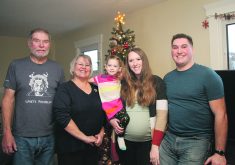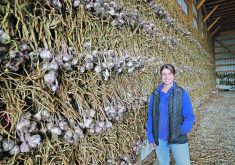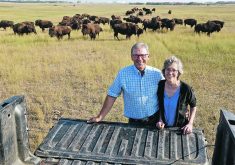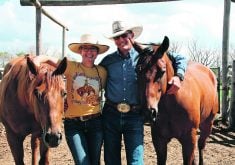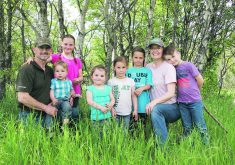KIRRIEMUIR, Alta. — The circle of family, community and relationships embrace Craig and Jinel Ference.
Recently named Alberta’s outstanding young farmers, the couple lives in the southeastern Alberta community of Kirriemuir near the Saskatchewan border.
Becoming part of the young farmer alumni expands their community.
“For us, it is a huge opportunity to meet different people and see what they are doing in the ag business. It is a wonderful opportunity for us,” Jinel said.
The couple did not know much about the program until their nomination, but Jinel’s uncle was a founder of the program more than 30 years ago.
Read Also

Nutritious pork packed with vitamins, essential minerals
Recipes for pork
Craig is the fourth generation Ference to farm in the region known as Special Areas Four.
His parents, Harvey and Joyce Ference, started the present farm site in 1985. It was a mixed farm and when Craig returned from university, they expanded the operation. He had met Jinel at the University of Alberta where he studied business and she earned a degree in education.
It has grown into a unique four enterprise operation with a custom cropping, cash crops, feedlot and cow-calf operations.
His parents are not involved day to day anymore but they are part of the management decisions and still help when needed.
“They are kind of like our board,” Craig said.
Added Jinel: “It is a good time in life. As they want to step back, Craig and I can step up more. It is a good balance for all of us.”
Double F Farms run about 4,000 Angus-Simmental cross cows, maintains a 7,500 head feedlot and owns and rents land in a 35 kilometre radius, as well as a farm at Biggar, Sask., about 180 km from their home.
“We are basically from Rimbey to Yorkton,” Craig said.
“We do that for risk mitigation for drought so if it is dry in one area we can move the cattle. We are on the road a lot,” he said.
About 750 cows run on the Saskatchewan place Craig bought in 1999 when he was 18. The land prices were more affordable and it gave him a chance to build.
Such a busy operation takes organization and about 20 employees.
“We are fairly unique for our diversification. There are not too many four enterprise farms,” he said.
“They (the farm locations) complement each other. It is definitely a challenge at times to manage them all properly but it comes back to our men. If I didn’t have those key operators, we probably wouldn’t have gone into the custom business.”
Some foreign workers on their farms work on a seasonal basis and return to their own farms in the off-season.
Others have become permanent residents and some are seeking Canadian citizenship. They brought their families with them and are willing to settle in a rural area with a five-room schoolhouse offering kindergarten to Grade 12.
“We have quite a bit of culture in our little school,” Jinel said.
“We are very lucky because our community is very welcoming.”
Craig found these workers after he started an employment placement agency while still in university. He had already worked for a year in Australia and made contacts with people interested in the Canadian farm experience.
People aged 18 to 30 can get a one-year visa but it remains difficult bringing in foreign workers and it is almost impossible to hire Canadians even though they offer good wages and benefits.
“I don’t want cheap labour, I want good labour. There were zero people who applied,” he said.
Plus, they want trustworthy people with specific skills who can manage cattle, run heavy equipment or bring other talents like welding, mechanics or carpentry.
There are regular staff meetings and parties after seeding, calving and harvest.
During the busy seasons of silaging and harvest, Jinel is the cook and manages meals in the field for crews of eight to 12 people. The crews and their three children, Maddie, 8, Nate, 6 and Macy, 3, all enjoy the break.
“The guys need a break and our kids love it. The more our crew sees our family, the more they are aware of them and know they exist in the farmyard,” she said.
The friendly approach boosts morale.
“If Craig had to go across the world and work somewhere to support us, I would really want someone to welcome him with open arms and be empathetic to him leaving his family, so we try to do the same. When they come here, we know it is a huge challenge for them and we want to be very welcoming to their families and make a home for them,” Jinel said.
After the market collapse of BSE, the Ferences switched the cow herd from a Continental-type to an Angus-Simmental cross herd, which has been closed since 2012. Craig is a volume bull buyer every year from Lewis Farms at Spruce Grove, Alta., and LLB Angus at Erskine, Alta.
“It is a relationship. I really believe the Lewises have the best genetics in the world but I also buy from them because it is a very good family,” he said.
Calving starts in April on native grass and weaning is in September.
After calving, the cows leave and the pastures rest over the summer.
“That is how we mitigate our disease pressures like scours and naval infections,” he said.
They finish all their own cattle at their feedlot on homegrown grain and silage. Everything is sold on the rail to Cargill Meats or JBS.
Craig markets calves throughout the year via phone.
“They used to come out and look at the pens but now they know what they are getting because it is consistent every year,” said Jinel.
Probably 80 percent of their cattle grade AAA so they know their genetics are performing as expected.
The average annual precipitation for the region is about 350 millimetres, although last year was very dry.
Seeding starts at the end of April and takes about six weeks to complete because of the amount of deeded and rented land.
They also do custom seeding and make silage.
They are able to grow canola and pulses but in recent years, more attention is paid to growing corn for silage and grazing.
“Corn is my passion,” Craig said.
“We can actually graze, silage and earlage and combine so we get four end products,” he said.
He started four years ago with 40 acres of corn and this year he plans to seed 9,000 acres.
To make earlage, the cobs are stripped off and the stalks are left behind. The cows graze the stalks in winter.
The cobs are chopped like silage and offer 20 to 40 percent moisture. They make a high quality feedlot ration mixed with barley and other feeds recommended by their nutritionist.
The Ferences seek out advice from key consultants and this year an agronomist is on hand for most of the summer. Craig used to do most of the agronomy work but does not have the time. He manages the farm from an office but prefers to be outdoors with the cattle or in the fields.
During slower periods, the Ferences like to travel to Europe and Australia to sight see and visit people who worked for them and learn more about farming in other countries.
Expansion continues to be their plans with support from Craig’s parents.
“Our strategy was to own cash-producing assets like the feedlot or grain farm and rent long-term assets, like the farmland,” he said.
“We did it together. I was an aggressive young guy. I had this vision and dream but my dad also had a vision and dream and he did not hold me back,” he said.
Added Jinel: “We started with a very good foundation.”
The Ferences are using that good foundation to build a strong future for their children.
“If we have this great foundation for our kids and the types of things they could grow from it and the enterprises they can grow from it, yes, they may want to come home and strictly farm and that is great. Maybe they don’t want to farm. Maybe there is a business they can start from what is here,” Jinel said.
“We are pretty fortunate we have three generations on this farm working together and planning together.”







